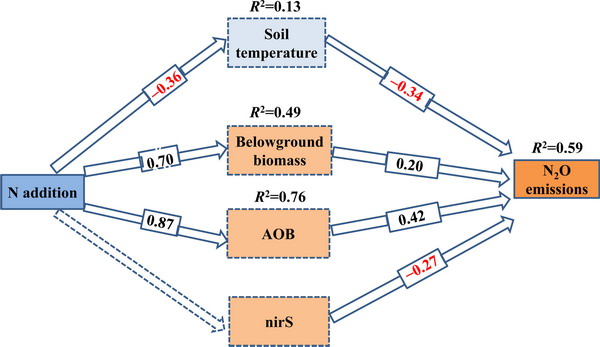Anthropogenic-driven global change, including changes in atmospheric nitrogen (N) deposition and precipitation patterns, is dramatically altering N cycling in soil. How long-term N deposition, precipitation changes, and their interaction influence nitrous oxide (N2O) emissions remains unknown, especially in the alpine steppes of the Qinghai–Tibetan Plateau (QTP). To fill this knowledge gap, a platform of N addition (10gm-2 year-1) and altered precipitation (±50% precipitation) experiments was established in an alpine steppe of the QTP in 2013. Long-term N addition significantly increased N2O emissions. However, neither long-term alterations in precipitation nor the co-occurrence of N addition and altered precipitation significantly affected N2O emissions. These unexpected findings indicate that N2O emissions are particularly susceptible to N deposition in the alpine steppes. Our results further indicated that both biotic and abiotic properties had significant effects on N2O emissions. N2O emissions occurred mainly due to nitrification, which was dominated by ammonia-oxidizing bacteria, rather than ammonia-oxidizing archaea. Furthermore, the alterations in belowground biomass and soil temperature induced by N addition modulated N2O emissions. Overall, this study provides pivotal insights to aid the prediction of future responses of N2O emissions to long-term N deposition and precipitation changes in alpine ecosystems. The underlying microbial pathway and key predictors of N2O emissions identified in this study may also be used for future global-scale model studies.

FIGURE 5 Structural equation model (SEM) analysis examining the effects of N addition on biotic and abiotic properties and N2O emissions. AOB: ammonia-oxidizing bacteria; nirS: denitrifying microorganisms. Values on arrows represent standardized path coefficients. The marked red values represent significant negative effects. The dashed line means no significant effect. Results of model fitting: χ2 = 0.18, p = .23, RMSE = .12
This result was published in Ecology and Evolution with the title of “Nitrogen addition, rather than altered precipitation, stimulates nitrous oxide emissions in an alpine steppe”.
The link below will guide you to the reading:
